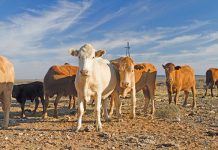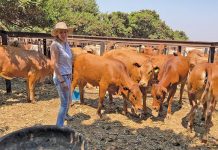Once summer rains fall, ticks, internal parasites and insect numbers will increase and then diseases such as African and Asiatic red water, anaplasmosis, blue tongue, lumpy skin disease, three-day stiff sickness, Rift Valley fever, Wesselsbron and African horse sickness may occur.
The following reports were received from practices in Mpumalanga (MP), Gauteng (G), Limpopo (L), North West (NW), Free State (FS), KwaZulu-Natal (KZN), Eastern Cape (EC), Western Cape (WC) and Northern Cape (NC):
Internal parasites

External parasites

Tick-borne diseases
The prevailing belief is that tick-transmitted diseases occur mainly in summer. Reports received from most provinces show this is not the case, and farmers should be on the lookout for clinical signs so that animals can be treated in time.
Insect-transmitted diseases
Now is the time to order vaccines for these diseases so that animals can be vaccinated in time before the rainy season starts in the summer rainfall areas.
Venereal diseases

New cases of trichomonosis are reported every month and this disease is getting out of hand.
Bacterial diseases

Viral diseases

The incidence of snotsiekte is increasing due to game farming. As there is no vaccine against this disease at present, it has to be managed. Discuss measures with your vet.
The same can be said for EBL – this debilitating disease costs the dairy farmer huge amounts of money.
There is no treatment for viruses – animals have to be protected by vaccinations. Discuss vaccination programmes with your vet.
Poisonings

Multifactorial diseases & other conditions

Metabolic diseases

Reproductive diseases
FEEDLOT REPORT
Sheep feedlots
- *Great losses occurred due to Salmonella Typhimurium infection. Infected sheep with diarrhoea arrived at the feedlot and started dying within days. Severe damage occurs in the intestine, especially in the last part of the small intestine and large intestine. Sheep surviving after treatment are not well, eat very little and hardly pick up weight. It is suspected that infection takes place when carrier animals transmit the disease to other animals when they are kraaled. The lambs are more susceptable and together with stress caused by transportation, clinical signs are seen soon after arrival at the feedlot.
- Eye infections often occur. Vitamin A deficiency is mostly the contributing factor this time of the year where poor nutrition for sheep is available.
- Clostridium septicum infections (gas gangrene) occurred where shearing wounds were infected.
- Prolapses of the rectum occurred in fat sheep where dusty conditions induced coughing of sheep.
- A few cases of urolithiasis (stones in the urethra) were seen.
- Pulpy kidney, blood gut and acidosis were reported.
Cattle feedlots
- Many cases of pneumonia occurred causing many deaths. Dust and fluctuating environmental temperatures together with an increase of cattle in feedlots contributed to the increase of lung problems.
- Acidosis, red gut, bloat, damage to the rumen wall and abscesses were due to nutritional disturbances.
- Lameness due to injuries and foot rot were seen.
- Lice infestations were common.
- Blue tick numbers increased and cases of red water and anaplasmosis occurred.
- Bont-legged ticks were numerous.
- Ringworm and warts were numerous. Warts were even seen in the rumen and reticulum of a few animals.
- Abscesses were seen.
















